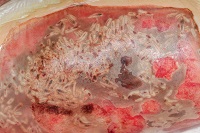Magnificent maggots
Sometimes the best treatment plan can include an effective and simple intervention of antiquity.
In today's world of incredible technology advancements, it is sometimes tempting to jump to the newest, flashiest tool to solve a medical problem. We must remember, though, that sometimes the best treatment plan can include an effective and simple intervention of antiquity.
A 63-year-old woman was admitted to our service with a complex health history, including autoimmune hepatitis, deep venous thrombosis, pulmonary embolism, diabetes, and chronic lower-extremity edema. She presented with calciphylaxis and had been treating her wound with a soap/spray cleanser/cream regimen and cinacalcet. She was admitted to our inpatient dermatology service and began tissue plasminogen activator (tPA) therapy in conjunction with wound care plans for antiseptic whirlpool and wet dressings. Cinacalcet was discontinued after the patient became symptomatically hypocalcemic and hypotensive. The tPA treatment was discontinued on the first day due to bleeding complications. Hyperbaric oxygen therapy was considered, but an outside hyperbaric facility did not have evidence that the technique would work for calciphylaxis.

The solution was maggot larval debridement therapy. The patient received 3 rounds of this therapy, which were well tolerated. After local debridement by plastic surgery, wet dressings, and twice-daily whirlpool baths, the calciphylaxis-induced ulcers improved. By 6 months post-hospitalization, the patient's wounds were almost completely healed.
While observations of the benefits of maggots in wound healing are found as far back as in the 16th century medical writings of Ambrose Paré, maggots were first intentionally placed in wounds during the Civil War (11. Graner JL. S.K. Livingston and the maggot therapy of wounds. Mil Med. 1997;162:296-300. [PMID: 9110559]). Surgeons of that time noted that necrotic tissue was more satisfactorily cleaned with maggots than with any other available antiseptics. Of interest, though, this method of wound debridement was used only by Confederate troops, as Union medical teams declined the use of the technique due to its repulsiveness.

After the war, orthopedist William Baer, MD, became the first to standardize and publish a scientific article about maggot therapy. Dr. Baer trained Stanton Livingston, MD, who carried on the study of therapeutic maggots after his mentor's death in 1931. Dr. Livingston utilized a different species of maggots than his mentor, those from green bottle flies (Calliphora erythrocephala). He addressed the issue of repulsiveness noted by Union medics (and no doubt many of us in the modern era of medicine) by perfecting a method of sterilization—washing the maggot eggs in a solution containing bichloride of mercury and 95% alcohol. Afterward, he cultured samples of eggs for anaerobic growth, and if any growth was observed, the entire batch of maggots was immediately discarded. Dr. Livingston's first publication on maggot therapy in 1932 touted a 95% cure rate for cases of osteomyelitis. This success he credited not only to “mechanical action of the maggots … but rather that some additional agent is developed that aids in the healing process,” an agent that he named the “active principle” (22. Livingston SK. Maggots in the treatment of chronic osteomyelitis, infected wounds, and compound fractures. Surg Gynecol Obstet. 1932;54:702-6.).
Later referred to as maggot extract, the active principle contained sulfhydryl radicals, natural allantoin, calcium, cysteine, glutathione, and “embryonic growth stimulating substances” (33. Livingston SK. Therapeutics of maggot active principle. Am J Surg. 1937;35:554-6.). This active principle, even in concentrations as little as 5% extract in a jelly base, was tied to improvements in skin conditions such as abscesses, boils, carbuncles, burns, anal fistulae, anal fissures, internal hemorrhoids, and chronic leg ulcers (44. Livingston SK. Clinical results following the use of surgical jelly containing the maggot active principle. Am J Surg. 1938;41:49-50.). Despite the success garnered from utilizing maggot therapy to cure various dermatologic and orthopedic conditions, the importance of Dr. Livingston's position as a leader of maggot therapy research was effectively obliterated as research progressed in the promising realm of antibiotics.
After a decades-long hiatus, maggot therapy, primarily with Phaenicia (Lucilia) sericata, experienced a renaissance of sorts in the early 1990s. Despite modern medicine's slew of antibiotics, surgical debridement techniques, and wound care specialists, chronic wounds remain to this day a significant cause of morbidity and mortality, associated with enormous financial burden.
Maggots offer a trifecta of debridement, antimicrobial action, and growth promotion combined with their minimal side effect profile, allowing this therapy to be successfully used for pressure ulcers, chronic leg ulcers, diabetic foot ulcers, traumatic wounds, amputation sites, or skin infections that are refractory to other conventional treatments. Insufficient blood flow, dry necrotic wounds, fistulae, and easily hemorrhagic wounds are generally contraindications to maggot therapy (55. .Johnson S. Use of Sterile Maggots in Wound Management Policy, 5th ed. Doncaster and Bassetlaw Hospitals, NHS Foundation Trust. March 2015. Accessed online. ). Once the wound is cleaned and prepped with a hydrocolloid sheet, maggots are placed into the wound and a nylon net that allows drainage is affixed to the wound's perimeter. After approximately 3 days, the typical time to full growth, maggots are removed by gloved hand or with forceps.
For those of you who are squirming in your seats … yes, all maggots eventually do return to the surface of the skin (especially with a stream of sterile water) for removal, and no, maggots do not mature into flies or reproduce within the wound (55. .Johnson S. Use of Sterile Maggots in Wound Management Policy, 5th ed. Doncaster and Bassetlaw Hospitals, NHS Foundation Trust. March 2015. Accessed online. ).



